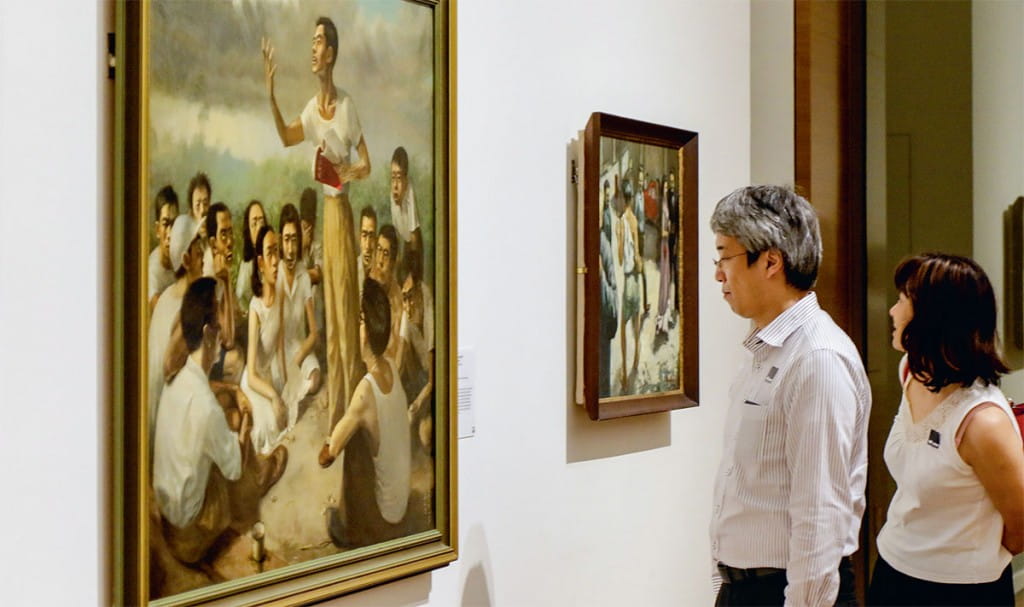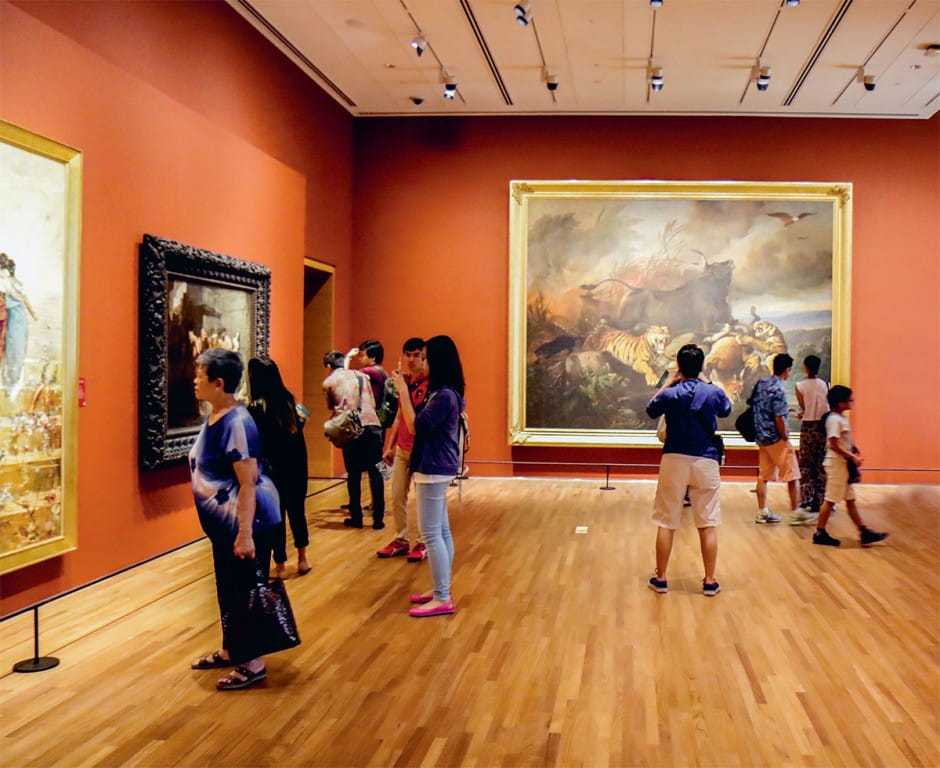Stories > Mapping a Common Language
Mapping a Common Language

Museum visitors pause in front of Singaporean artist Chua Mia Teeʼs Epic Poem Of Malaya at the UOB Southeast Asia Gallery.
DR EUGENE TAN, director of National Gallery Singapore, explains why he is intent on bringing South-east Asian art into the spotlight and shares his vision of the museum as a platform for fostering better understanding of the region.
PHOTOS NATIONAL GALLERY SINGAPORE, SPH LIBRARY
or a foreigner arriving in a new country, having an understanding of the country’s art and culture provides the best insight into a society. Art also helps to build bridges with other communities, and allows others to have a clearer understanding of a society’s collective soul and way of life.
This is something that the National Gallery Singapore, which opened in November last year, is attempting to do within South-east Asia. Housed across two heritage buildings – the former Supreme Court and City Hall – the Gallery is integral to art development in the country. It is home to the world’s largest public collection of South-east Asian art and is the only public museum in the world dedicated to the region’s art.
The Gallery will draw upon its extensive collection to present exhibitions and programmes that provide unique perspectives on the culture and heritage of Singapore and the region, and cultivate a greater awareness of the commonalities in the development of art among the different countries in this part of the world. This will, in turn, foster greater regional understanding.

Dr Eugene Tan is director of National Gallery Singapore. Previously, as programme director of the Special Projects unit at the Singapore Economic Development Board, he oversaw the development of Gillman Barracks, a visual arts hub in Singapore. He has held various positions in the arts, including director of exhibitions for Osage Gallery, director of contemporary art at the Sothebyʼs Institute of Art – Singapore, as well as director of the Institute of Contemporary Arts Singapore. He has curated various exhibitions locally and internationally, and has also presented at conferences and symposiums worldwide.
For instance, displayed in Gallery 7 of the UOB Southeast Asia Gallery are pieces created in the 1960s by, among others, Hernando R Ocampo in the Philippines, Cheong Soo Pieng in Singapore and Mochtar Apin in Indonesia. Despite being in different locations, the artists were all influenced by the same theme – the language of abstraction, which does not seek to depict physical reality but instead uses shape, form, colour and texture to convey meaning or emotion.
Their works during this period marked the start of new ways of representing the environments and societies of the region. They tell the story of shared experiences and impulses amid diversity, and are a reminder of the historical, social and political context which Singapore has been a part of.
SPOTLIGHT ON REGIONAL ART
The Gallery has two primary aims – to further the understanding of art from South-east Asia within itself as well as to a larger global context. Through our permanent exhibitions, we aim to give the public a critical understanding of art development across the region, highlighting artistic impulses and historical experiences.
Facilitating this are our museum partners in the region, including the National Museum of the Philippines, the Vietnam Fine Arts Museum in Hanoi, and the National Gallery in Bangkok. We have also signed memorandums of understanding with the latter two, allowing us to collaborate on new exhibitions, make loans, and exchange knowledge and expertise.
“I hope that in the long run, through the partnerships we have formed and will form, both in the region and internationally, we can start to form a more comprehensive picture of art development in South-east Asia, in relation to other parts of the world. More pertinently, it is my wish that with the help of art and culture, we can build more bridges between Singapore and the world.”
Dr Eugene Tan
We also want to explore the links between the art in the region and other parts of the world to strengthen the Gallery’s presentation of the art histories of Singapore and South-east Asia within a global context. This will be done through special exhibitions that feature changing exhibits curated and presented in collaboration with international art institutions.
Our first major collaboration, building on the strong cultural relations between Singapore and France, is with the Centre Pompidou in Paris. Titled Reframing Modernism, it will be presented in April in an exclusive exhibition co-curated by the two museums. The exhibition will look at the development of modernism and modern art from the perspective of artists from Europe and South-east Asia in the 20th century. A selection of artworks by important artists from the region and beyond will be presented, including Pablo Picasso (Spain), Henri Matisse (France), Affandi (Indonesia) and Georgette Chen (Singapore).
This will be followed by our second international partnership, with Tate Britain, in October this year, to bring in the exhibition Artist And Empire which was first shown at the Tate Britain in November 2015. The Singapore version will have a greater South-east Asia focus by featuring more works by artists from the region, but still stay true to the theme of how these artists explored and represented the conditions and experiences of the British Empire. The exhibition will examine the relationship between colonial experience and the rise of modern art in former colonies such as Singapore, and explore how contemporary artists reflect on the complex histories of the empire today.
We are also dedicated to research. One of the projects the Gallery is currently embarking on looks at the existing writings on modern art in South-east Asia. We seek to understand how and where it has been written about, who has written about it, and how it has been received. The aim is to consolidate the important texts, in order to provide a foundation for further study of South-east Asian art. This is important given the lack of publications on the subject, as well as its under-researched state.
At the end of the day, it is my hope that the Gallery will inject more dynamism into the art scene in the region and be a catalyst for other forms of collaborations.
I hope that in the long run, through the partnerships we have formed and will form, both in the region and internationally, we can start to form a more comprehensive picture of art development in South-east Asia, in relation to other parts of the world. More pertinently, it is my wish that with the help of art and culture, we can build more bridges between Singapore and the world.

Housed in the former Supreme Court building, the UOB Southeast Asia Gallery contains artworks from influential artists in the region.
